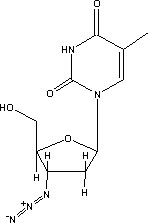SAN FRANCISCO -- Zidovudine monotherapy during the first trimester of pregnancy does not appear to increase the risk of birth defects detected at the time of delivery.
The finding comes from the largest U.S. prospective registry of the potential teratogenic effects of antiretroviral therapy detected at the time of birth, Dr. Patricia M. Garcia reported at the Seventh Conference on Retroviruses and Opportunistic Infections.
The registry does not yet contain enough accumulated pregnancy exposures to other antiretroviral agents used alone or in combination to reach any reliable conclusion regarding their teratogenic risk, said Dr. Garcia of Northwestern University in Chicago.
She reported on birth defects seen among 916 pregnancies in HIV-positive women prospectively enrolled in the Antiretroviral Pregnancy Registry during the last 10 years. The mean maternal age was 27 years.
So far, 343 live-born infants were exposed to any antiretroviral agent during the first trimester. The prevalence of birth defects detected at delivery in this group was 2.0 per 100 live births.
This rate is similar to that observed among infants exposed to any antiretroviral drug during the second and/or third trimester. Their incidence of birth defects was 2.7 per 100 live births.
The observed rate of birth defects is also similar to the expected rate in the general population, 2.2 per 100 live births, Dr. Garcia said at the meeting sponsored by the Foundation for Retrovirology and Human Health.
The greatest number of first-trimester exposures were to zidovudine monotherapy Among 111 live births in this group, there was one birth defect, for an incidence of 0.9 per 100 live births.
Of potential concern was that there were two cases of birth defects detected among 10 infants who were exposed to the combination of nucleoside reverse transcriptase inhibitors, nonnucleoside reverse transcriptase inhibitors, and protease inhibitors during the first trimester.
One of these infants had transposed organs and the other had renal pelviectasis.
These defects do not appear to have a related etiology, and there are too few reported exposures to accurately estimate whether the combination therapy carries a terarogenic risk, Dr. Garcia said. The observation warrants continued surveillance, she. added.
Prospective reports of antiretroviral exposures during pregnancy can be made to the Antiretroviral Pregnancy Registry by calling 800-258-4263.
COPYRIGHT 2000 International Medical News Group
COPYRIGHT 2001 Gale Group



